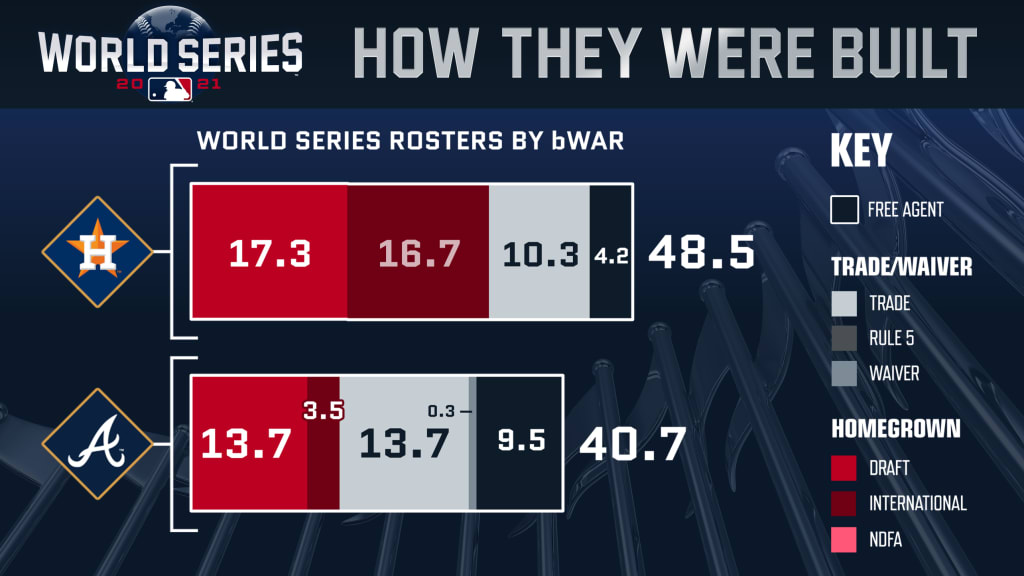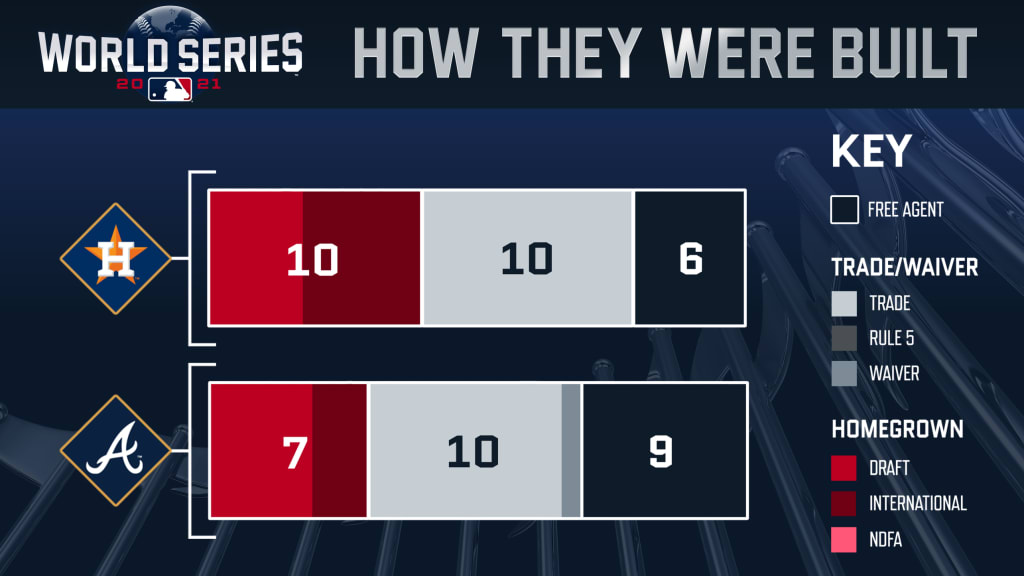
One team is back in the World Series after a one-year absence, carried there largely by a productive core of homegrown players, with a surprising postseason star coming via a trade few paid attention to at the time. The other team is back in the World Series for the first time since 1999, carried there by more of a balance of a productive core of homegrown players, solid free agent and trade acquisitions, with their own surprising postseason star also acquired via a smaller trade.
There are similarities in the blueprints, but the Astros and Braves carved their own unique paths to the World Series, which begins on Tuesday night at 8:09 p.m. ET in Houston.
The Astros have made it for the third time in the last five years, punctuating their fifth straight postseason appearance. While this is the first time the Braves have been playing for a ring in 22 years, they have made the playoffs four years in a row, though their run this year may have seemed improbable at the start of the postseason, given they had the worst record of any playoff team. The Astros, for their part, had the second-best record in the American League. And while the Braves' payroll was slightly higher than the Astros', both organizations were just above the league average in 2021.
Like in any year, these franchises show there is more than one way to build a winner, but there’s a good amount of common ground. Both clubs have a group of homegrown players that have led the way. The Braves’ group is smaller, especially with injuries to Mike Soroka and Ronald Acuña Jr. keeping two main members of this category on the shelf. But there’s still Freddie Freeman (2007 Draft, second round), Austin Riley (supplemental first round, 2015) and international signee Ozzie Albies, all of whom slugged 30 or more homers and compiled a combined 14.3 WAR during the regular season. On the pitching side, former first-rounder Ian Anderson (2016) will again help lead the pitching staff.
Houston’s homegrown crop is a bit larger than Atlanta’s (10 vs. eight), and was more productive in 2021, thanks largely to the efforts of former top-of-the-first-round picks Carlos Correa (No. 1 overall, 2012) and Kyle Tucker (No. 5 overall, 2015), who combined for 12.9 WAR. Fellow 2015 draftee Alex Bregman (No. 2 overall) missed a lot of time, but still chipped in with 2.1 WAR, while drafted rookies like Chas McCormick and Jake Meyers made surprising contributions to the offense, though Meyers was left off the World Series roster because of injury. The pitching staff would have been led by another original draftee, Lance McCullers Jr., but he’s out due to injury. So that has left homegrown international signees like Framber Valdez, Luis Garcia and José Urquidy to lead the way. That’s half of the international homegrown contingent that combined to produce 16.7 WAR (Jose Altuve contributed 4.4 of that.).
Both teams have made trades to augment their rosters, with the most successful acquisitions being a bit more under-the-radar, at least at the time, starting with both League Championship Series MVPs. Eddie Rosario was obviously a known quantity with seven years in the big leagues on his resume. He had been having a relatively ho-hum season with the Indians (0.6 WAR) that included an oblique injury that had him on the injured list at the time of the trade. The Braves were able to get him and cash considerations for veteran Pablo Sandoval (who was released by the Indians) in what was more or less a salary dump. Not only did Rosario hit well upon his return (.903 OPS), he went off in the NLCS with a .560/.607/1.040 line that included three homers and nine RBIs. He, Adam Duvall and Joc Pederson have helped create stability with an all-Deadline-acquisition outfield.

The Astros’ Deadline moves also may not have made national headlines, but they were able to add a trio of arms that were very helpful down the stretch and in the postseason. Kendall Graveman (6 G, 7 IP, 1 ER) came from the Mariners, Phil Maton came over from the Indians and has given up one run over 6 2/3 innings, while Yimi García, acquired from the Marlins, has been less effective in the playoffs. And getting All-Star closer Ryan Pressley from the Twins for a pair of Minor Leaguers back in 2018 was a steal as well.
In many ways, the teams’ abilities to find talent via the acquisition of Minor League players stands out even more. The Astros nabbed ALCS MVP Yordan Alvarez from the Dodgers back in 2016 for reliever Josh Fields and helped him develop into a slugger who had 33 homers and 3.2 WAR during the regular season, then nearly matched Rosario with a ridiculous .522/.538/.870 line in the Astros’ win over the Red Sox.
The Braves’ biggest move in this regard, of course, was buying low on Max Fried. The left-hander had been a first-round pick of the Padres back in 2012 and had recently undergone Tommy John surgery when the Braves got him as part of the Justin Upton trade. Fried missed all of 2015, then made his way slowly up Atlanta’s ladder to get to the big leagues in 2018. His efforts in Game 2 of the NLDS and Game 1 of the NLCS are a big reason why the Braves are here.
Both club’s efforts on the free-agent market have been relatively minor, but have paid some handsome dividends. The Astros signed Michael Brantley back in December 2018, then re-signed him for two more years this past offseason, and he turned in a solid regular season (2.1 WAR) while hitting .311 this postseason. Ryne Stanek was a much smaller free-agent signing this offseason, but he’s been a workhorse out of the bullpen and has appeared in eight games this postseason, winning two games and giving up one run in 6 2/3 IP.
Similarly, the Braves’ most important free-agent signing has turned its bullpen into a force. Atlanta signed Tyler Matzek as a Minor League free agent in August 2019 after the D-backs had released him. Not only has he accrued 2.9 WAR over the course of the 2020-21 regular seasons, he’s been absolutely filthy in the postseason. This year, the lefty has appeared in all but one of the Braves’ 10 playoff games, striking out 17 in 10 1/3 innings and could have made a claim to NLCS MVP honors if it hadn’t been for Rosario’s offensive explosion.
Jonathan Mayo is a reporter for MLBPipeline.com. Follow him on Facebook and @JonathanMayo, and listen to him on the weekly MLB Pipeline Podcast.
